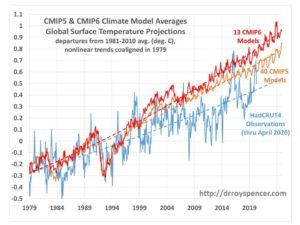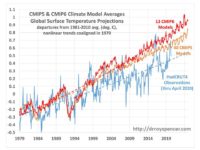The philosopher G.F. Hegel is notorious for having said that if facts contradict theory, then “um so schlimmer für die Fakten”—“so much the worse for the facts.” Not surprisingly, the idealist Hegel had a huge influence on another idealist philosopher, Karl Marx, whose “scientific socialism” was socialist but decidedly not scientific. Facts have never seemed to matter much to socialists—it’s theory that counts.
Perhaps that underlies the propensity for some climate scientists to insist not only that human activity contributes to global warming (to which every “climate skeptic” I know agrees) but that we make it catastrophic, indeed, an “existential threat” to human wellbeing.
That’s about as good an explanation as I can come up with for the perennial failure of scientists who believe in catastrophic anthropogenic global warming (CAGW—I think I was the one who coined the phrase, or at least made it common enough about 15 years ago to warrant the acronym) to grapple with the nasty fact that facts contradict their computer climate models—the sole basis of predictions of future global temperature (and whatever else they think depends on that: more frequent and powerful hurricanes, heat waves, cold snaps, droughts, floods, wildfires, shrinking sheep, surge in shark attacks, severe acne, snow in Baghdad—you get the drift).
Honestly, the situation would be humorous if the consequences weren’t so dire. $70 trillion here, $140 trillion there—pretty soon you’re talking about real money.
Dr. Roy W. Spencer, a NASA award-winning principal research scientist in climatology in the Earth Systems Science Center at the University of Alabama-Huntsville (full disclosure: a friend of mine and member of the board of The Cornwall Alliance for the Stewardship of Creation, of which I’m president), poked fun at the climate alarmists with this famous graph back in 2014:

You would think—well, if you’ve been watching for long, maybe you’d just hope, a bit forlornly—the alarmists might have learned their lesson.
The lesson is no deep secret, after all. It’s not among the more difficult lessons of science—like the General Theory of Relativity, time dilation, or quantum theory. It is, instead, what Nobel Prize-winning physicist Richard Feynman called (in what became a viral video about 50 years later) “the key to science.” A key, you might recall, is what gets you into something. Without it, you’re an outsider.
Said Feynman:
In general we look for a new law by the following process. First we guess it. Then we compute the consequences of the guess to see what would be implied if this law that we guessed is right. Then we compare the result of the computation to nature, with experiment or experience, compare it directly with observation, to see if it works. If it disagrees with experiment it is wrong. In that simple statement is the key to science. It does not make any difference how beautiful your guess is. It does not make any difference how smart you are, who made the guess, or what his name is—if it disagrees with experiment it is wrong. That is all there is to it. [Richard Feynman, The Character of Physical Law (London: British Broadcasting Corporation, 1965), 4, emphasis added.]
So, did the climate alarmists—that is, the people who dominate the United Nations’ Intergovernmental Panel on Climate Change (IPCC), and the United States Global Change Research Program, and pretty much all the relevant government agencies around the world, the environmental activist organizations, and the political class—even such brilliant scientists as Greta Thunberg—learn their lesson? Did they go back to the drawing board?
No. Hegel would be proud of them. Um so schlimmer für die Fakten!
How do I know that? Well, it’s not difficult. You just update Spencer’s 2014 graph and apply it not only to the fifth-generation climate models of the past but also to the sixth-generation models of today.
Here’s what you get:



No, you’re eyes aren’t deceiving you. The sixth-generation (CMIP6) models are worse than the fifth-generation models! You’d have thought that after six years and billions of dollars spent on improving the models, the results would be better. Alas, hope springs eternal.
Why this is so important is that it’s these models that are at the heart, the foundation, the root, the everything of the IPCC’s Sixth Assessment Report (AR6) which made its debut with volume 1, The Physical Science Basis (all 3,949 pages of if!) this summer. Everything the IPCC warns about for future global temperature and the existential threats allegedly arising from it (okay, AR6 never uses existential threat—something politicians and the media don’t seem to notice) rests on those models. And the fact is, as Feynman would gently and politely put it, “If it disagrees with experiment it is wrong. … It does not make any difference how beautiful your guess is. It does not make any difference how smart you are, who made the guess, or what his name is—if it disagrees with experiment it is wrong. That is all there is to it.”
I would add, by the way, something Feynman didn’t say but that I’m certain he would agree with: It doesn’t matter how many people agree with your guess—even if it’s 97 percent (which it isn’t). But then Feynman wrote back when most scientists knew that argumentum ad populum was a fallacy, so I guess he didn’t think it necessary to mention it.
So we know the IPCC scientists’ guess (Feynman’s term—they’d call it a theory, which sounds so much more sophisticated) as to how much warming will come from added CO2 in the atmosphere is wrong. It’s wrong because the consequences computed from it disagree with experiment—the experiment we’ve been running with the whole Earth and its whole climate system for several generations and for which we have good observational (especially satellite) data running back to 1979.
But why is it wrong?
First, because all the models just assume that CO2 is the control knob for global temperature. They include other inputs, yes, but they treat CO2 as determinative. The others are just along for the ride as feedbacks (more on that in a moment). Yet insofar as CO2 and global temperature correlate, they correlate the wrong way for this assumption. Temperature leads, CO2 lags, by 800 ± 200 years. So if there’s any causal relationship there, it’s the opposite of what the models assume.
Partly, too, because they assume feedbacks—especially clouds—are positive. That is, they assume that if CO2 causes a little warming, water vapor and other contributors to greenhouse warming respond in a way that, on net, magnify that warming. But water vapor and clouds are the most important feedbacks, and empirical observation—what Feynman meant by experiment—shows they’re a negative feedback. They shrink the warming, they don’t expand it. This is why the models yield “climate sensitivity” (the warming expected from doubling atmospheric CO2 concentration) that is too high.
And there’s another reason why the models “run hot.” University of Delaware Climatologist Dr. David Legates (more full disclosure: he’s a friend, too, and a Senior Fellow of the Cornwall Alliance) explained it in a recent article. In addition to setting “climate sensitivity” too high, the models assume too much future atmospheric CO2 accumulation (the rough meaning of “Representative Concentration Pathways” used by the IPCC). Too much CO2 plus too much warming inferred from CO2 means too, too much warming.
There are more reasons than these why the models “run hot,” but these are a good start.
But don’t take my word for it. Even a group of IPCC-contributing scientists recently analyzed 38 climate models and concluded:
For lower-troposphere and midtroposphere layers [which together contain the vast majority of the atmosphere, including the part most relevant to the biosphere] both globally and in the tropics, all 38 models overpredict warming in every target observational analog, in most cases significantly so, and the average differences between models and observations are statistically significant.
So, the IPCC’s Sixth Assessment Report, which UN Secretary-General Antonio Guterrez and the fawning media called “code red for humanity,” is no cause for panic—or even for worry. Not if you understand the “key to science.”
* This article was originally published here
HELP STOP THE SPREAD OF FAKE NEWS!
SHARE our articles and like our Facebook page and follow us on Twitter!





0 Comments